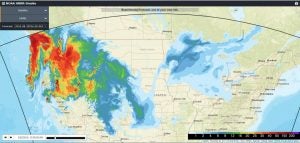The western half of the United States has been up in smoke from 110 large fires that have erupted across the region during this fire season. And now NASA estimates over 1.9 million acres are or have been ablaze.
The weather concerns in the area include warmer than average temperatures that will continue in the west with diurnal winds and marginal overnight humidity recoveries. Isolated storms will be possible along and west of the Continental Divide in Montana and Wyoming. These storms could also bring more lightning strikes and more blazes to the area with increasingly dry conditions.
A breezy easterly flow will blow across the western half of Montana and possibly northern Idaho that could possibly allow fires to spread farther. With the center of the high pressure area located mostly over southern California, the normal wind flow will be suppressed and the rain that might come to this area will be contained mainly in areas near the Mexican Border certainly not helping firefighting efforts. Further north, low pressure will bring cooler temperatures and possibly isolated storms to the Pacific Northwest.
Over the weekend six new large fires were reported in Idaho, Nevada, and Oregon while eight large fires were contained including the Ferguson Fire near Yosemite National Park in California.
Smoke from these fires have traveled along the west to east jet stream and are bringing that smoke across the country as far as the East Coast.

Smoke from any type of wildfire is dangerous. The smoke released by any type of fire is a mixture of particles and chemicals produced by incomplete burning of carbon-containing materials. All smoke contains carbon monoxide, carbon dioxide, and particulate matter (PM or soot). Smoke can contain many different chemicals, including aldehydes, acid gases, sulfur dioxide, nitrogen oxides, polycyclic aromatic hydrocarbons (PAHs), benzene, toluene, styrene, metals, and dioxins. The type and amount of particles and chemicals in smoke varies depending on what is burning, how much oxygen is available, and the burn temperature.
Exposure to high levels of smoke should be avoided. Individuals are advised to limit their physical exertion if exposure to high levels of smoke cannot be avoided. Individuals with cardiovascular or respiratory conditions (e.g., asthma), fetuses, infants, young children, and the elderly may be more vulnerable to the health effects of smoke exposure.


